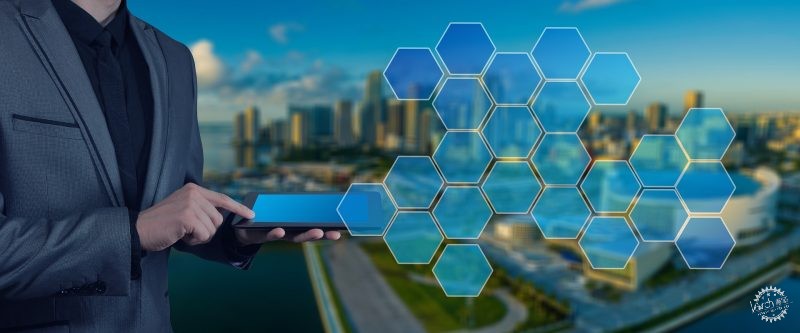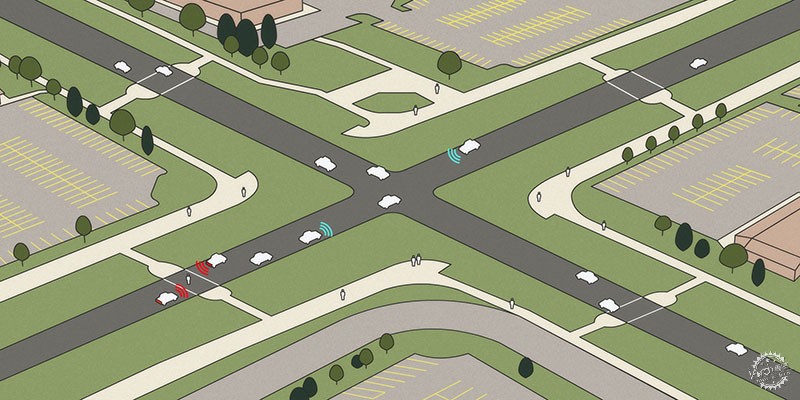
AI正在塑造城市的8种方式
8 Ways AI is Shaping the City
由专筑网孙佳,李韧编译
人工智能(AI)是当前热门话题,目前风靡世界。这个概念几乎渗透到每个行业,并用于创造更好的产品和服务。但究竟什么是AI,以及它如何影响城市设计?设计师未来需要考虑哪些潜在关系?在本文中,我们将介绍AI影响城市的一些方式,并研究这些方式可能对我们未来的职业产生何种影响。
什么是人工智能?
人工智能是用于描述,如何使用数据分析和高级算法来更好地实现特定目标,从而训练机器学习经验的术语。这个术语最早来源于1956年,但随着信息技术和数据收集的进步,人工智能近年来越来越受欢迎。
1. 人工智能将改变街道设计
自动驾驶汽车当前已经成为现实。芬兰VTT公司开发了一种名为Marilyn的全自动驾驶汽车,该汽车使用激光雷达,能够在“雾天和雨雪等恶劣天气条件”下检测并避开道路上的行人。人工智能用于处理来源于传感器的信息,并与互连网络中的其他车辆共享此信息。
城市导航的进步将减少城市的拥堵状况。还可以设计成为更安全的共用表面系统,车辆和行人之间的事故将减少。自动驾驶汽车能够持续地减少人工汽车拥有量。智库Rethink预测,最迟在2030年,95%的美国旅客将运用自动电动汽车,从而减少对个人汽车的需求。这将导致道路上的车辆总数减少,这也意味着街道宽度和车道数量的减少。
Artificial intelligence, or AI, is a buzz word that is currently taking the world by storm. AI has infiltrated almost every sector and is being used to create better products and services. But what exactly is AI, and how might it effect urban design? What are the potential benefits and things designers need to consider for the future? In this article we look at some of the ways AI is already influencing the city and examine what impacts these may have on our profession in the future.
What is Artificial intelligence?
Artificial intelligence is the term used to describe how machines can be trained to learn from experience using data analysis and advanced algorithms to better achieve specific goals. Although the term was originally coined as early as 1956, AI has become increasingly popular in recent years with advancements in information technology and data gathering.
1. Artificial Intelligence Will Change Street Design
Autonomous or self-driving cars are already a reality. Finnish firm VTT has developed a fully autonomous vehicle called Marilyn that uses LiDAR to ‘see’ through adverse weather conditions like fog and snow to detect and avoid pedestrians in the road. Artificial intelligence is used to process information gathered from sensors and share this information with other vehicles in an interconnected network.
This advancement in urban navigation will result in less congestion in our cities. It will also be possible to design safer shared surfaces where vehicles and pedestrians can coexist without incident. Self-driving cars are likely to amplify the current trend in reduced car ownership. Think tank Rethink predicts that by as early as 2030 ‘95% of U.S. passenger miles traveled will be served by on-demand autonomous electric vehicles’reducing the need for personal car ownership. This will result in an overall reduction in the number of vehicles on our roads, meaning that streets will be able to be narrower, with fewer lanes.

Image courtesy of Short Elliott Hendrickson Inc. (SEH®). http://www.sehinc.com/
2. 自动驾驶汽车将改变城市结构
“按需”自动驾驶汽车将使用户能够在需要时使用优步等服务来呼叫汽车,这意味着停车设施可以集中,减少对当地停车场和路边停车的需求。这些多余的停车场可能为口袋公园以及城市绿道。
3. 能源效率
也许人工智能对于影响城市的方式还存在于,通过快速和智能的数据分析来实现能源效率。例如,总部位于英国的Vivacity公司正在使用AI通过更好的自动交通信号灯来开发可持续的交通管理,而IBM的Watson物联网和Echelon公司共同开发了一种名为Lumewave的创新型智能LED路灯控制系统。Watson的认知计算系统能够从灯具内的传感器收集实时数据,以及新闻和天气等外部信息源,根据需要智能地调整照明水平。
4. 自动规划
AI主要的一个优点是能够快速有效地处理大量数据,这对政策和空间规划具有重要意义。例如,先进的计算机模拟可以更好地预测城市洪水,最大限度地降低洪水风险。AI允许设计人员、决策者和政治家收集有关公共领域的数据,从而在资源分配和空间规划方面做出更好的决策。在未来,Ai还将使设计人员能够对其设计方案进行虚拟计算机模拟,分析其效率,并帮助设计合理化,减少社会负面行为。
5. 预测和缓解城市衰退
麻省理工学院(MIT)和哈佛大学的研究者已经开发出一种人工智能系统,它能够预测城市市区衰退现象,并向人们展示具有对比作用的城市环境照片,并且了解人们的偏好,从而预测未来城市环境的发展。有趣的是,该研究发现,与收入或房价相比,更高水平的教育和商业区的使用更能好的预测社区的发展。
2. Autonomous Vehicles will Alter the Fabric of our Cities.
‘On-demand’ autonomous vehicles will enable users to hail a car whenever they need using an Uber style service. This means that parking facilities can be centralised, reducing the need for local parking lots and on-street parking. These redundant parking lots may make way for pocket parks, urban greenways and redevelopment opportunities.
3. Energy Efficiency
Perhaps one of the more obvious ways in which AI can impact the city is through quick and smart analysis of data to enable energy efficiencies. For example, UK based firm Vivacity is using AI to develop more sustainable traffic management through better, automatic, traffic light sequencing. IBMIBM‘s Watson Internet of Things and Echelon Corp. have got together to develop an innovative intelligent LED streetlight control system called Lumewave. Utilising Watson’s ‘cognitive computing system that learns from experience’, the system will use both real-time data gathered from sensors within the light fittings, as well as external sources such as news and weather to intelligently adjust lighting levels as needed.
4. Automated Planning
One of the key benefits of AI is its ability to process large amounts of data quickly an efficiently. This has great implications for policy and spatial planning. For example, advanced computer simulations can better predict urban flooding, helping to identify opportunities for development, and minimise flood risk. AI allows designers, policy makers, and politicians to gather data about public realm usage to make better decisions regarding resource allocation and spatial planning. In the future, Ai will also enable designers to run virtual computer simulations of their proposals to analyse their efficiencies and help design out conflicts, crime, and antisocial behaviour.
5. Predict and Mitigate Urban Decay
The Massachusetts Institute of Technology (MIT) and Harvard University have developed an AI system that is able to predict urban decay in five American cities. By showing groups of people 1.6 million pairs of photos of urban environments taken several years apart and asking them questions about their preferences for these environments, the AI system was able to predict which urban environments would fare better in the future, and which would decay. Interestingly, the research identified that higher levels of education and access to business districts were a better predictor of the success of neighbourhoods than either income or house prices

MIT Creative Commons CC0
6. 增加娱乐机会
但是,一个可能引起争议的问题是AI在工作场所中的角色。一些专家预测,在中短期内,人工智能可以实现更高的任务自动化,从而减少人类在工作中需要花费的时间。工作时间的减少和休闲时间的增加将导致城市对办公空间的需求减少,以及对包括公园和城市绿地在内的休闲设施的需求增加。
7. 城市扩张
2016年,神奇宝贝Go(Pokémon Go)风靡全球。这款增强现实(AR)游戏在全球范围内拥有超过1900万的用户,所有用户都来到Pokestops和Gyms的城市,其中许多位于公园等绿地。AR的应用可以影响人们对城市的利用方式,公司已经提供AR应用程序来帮助探索城市环境,由此产生的数据也可以由人工智能处理,用于分析城市中的行为模式,并影响城市基础设施。在未来,设计师可以创建可容纳几乎无限数量设计作品的空间,因为每个用户都能体验个体(增强)现实的空间。
8. 智能措施,智能城市
AI在智慧城市概念中发挥着关键作用。许多城市开始在其管理中采用智慧城市的概念。这涉及数据收集和处理,以及通过实验和创新帮助改善城市和提高效率。例如,在中国杭州市,当地政府开发了“城市大脑”概念,利用人工智能为整座城市创建智能神经网络,分析和处理各种来源的数据,包括社交媒体和供水,这将导致犯罪率的降低,也减少拥堵和交通事故的发生。
人工智能的未来
人工智能已经在各种领域实施,如自动驾驶汽车、虚拟规划和现实增强,来改善城市环境。未来AI将进一步增强快速处理大量数据的潜力,从而制定更好的空间规划和设计方案。
6. Increase Opportunities for Recreation
A possibly contentious issue is AI’s role in the workplace. Some experts predict that in the short-to-medium term AI may allow for greater automation of tasks, thus reducing the number of hours humans need to spend in work. This reduction in work time and increase in leisure time will result in a reduced demand for office space in the city and increase demand for leisure facilities including parks and urban green spaces
7. Augmenting the City
In 2016 the phenomenon of Pokémon Go swept the globe. This augmented reality (AR) game saw peak users of over 19 million worldwide, all of whom were out in the city visiting Pokestops and Gyms; many of which were located in parks and other green spaces. The application of AR can impact upon how people use the city, with companies already offering AR apps to help explore urban environments. The data generated from this can also be processed by AI and used to analyse patterns of behaviour in the city and influence the positioning and nature of urban infrastructure. In the future it may be possible for designers to create spaces that can host an almost infinite number of designs, as each user experiences an individual (augmented) reality of a space
8. Smart Solutions, Smart City
AI plays a key role in the Smart City concept. Many municipalities are starting to adopt the concept of Smart City in their governance. This involves data gathering and processing to assist in improving cities and making efficiencies through experimentation and innovation. For example, in the city of Hangzhou in China the local government developed the concept of ‘City Brain’ to use AI to create a smart neural network across the city to analyse and process data from a variety of sources including social media and water supply. The results lead to changes that reduced crime, congestion, and fewer road accidents.
AI in the future
Artificial intelligence is already being implemented in areas as diverse as autonomous vehicles, virtual planning, and augmented reality to improve our cities. In the future AI will further unlock the potential to process vast amounts of data quickly, to make better spatial planning and design decisions.
|
|
